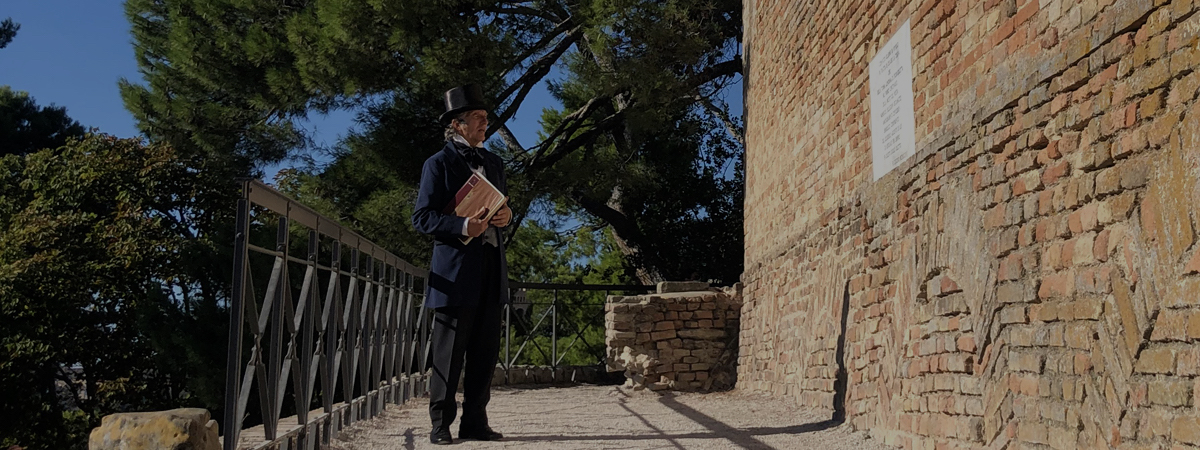VILLA COLLOREDO MELS
CIVIC MUSEUM
Via Gregorio XII – 62019 Recanati (MC)
T. 071 7570410 | recanati@sistemamuseo.it
Villa Colloredo Mels is a magnificent aristocratic villa with its oldest part of medieval origin, a 16th century staircase and its 18th century paintings that decorate the ceilings and the vaults. It takes its name from the Friulian family, the Colloredo Mels, who owned it in the mid- 1700s.
Since 1998, it has been the seat of the Civic Museum that is spread over three floors. On the main floor there is a section dedicated to Giacomo Leopardi, a famous poet, and the Art Gallery, with both medieval and Renaissance works on display. On the ground floor instead, the archaeological section consists of both a modern and a historical exhibition. The Leopardian section is full of books, documents, memorabilia and works of art that belong to the collection of the Municipality of Recanati.
Thanks to the donation made by the publisher Felice Le Monnier in 1881, the Art Gallery preserves the preparatory materials for the edition of Leopardi’s complete works started in 1845 by Antonio Ranieri and Leopardi’s death mask. Other works on display are “The Essay on the Popular Errors of the Ancients”, “a print proof of the Zibaldone”, preceding the proof that will be republished at the urging of Carducci, and portraits of some members of the Leopardi family: Monaldo, Giacomo, Pierfrancesco, Carlo, Paolina and Adelaide Antici.
The painter from Ancona, Giovanni Gallucci, created these portraits around the year 1860 and Teresa Teja, widow of Carlo Leopardi, donated them to the the Municipality of Recanati in 1898.
There is also a great number of letters written by Leopardi, among them a moving one addressed to his father.
The medieval section of the art gallery displays a collection of works from the 13th to 15th centuries. Among them, a fresco depicting the Annunciation that Olivuccio di Ciccarello painted for the Church of Sant’Agostino, is worth to be seen.
Other artists that embellish this section are: Giacomo di Nicola da Recanati, Pietro di Domenico da Montepulciano and Ludovico da Siena.
The Renaissance section of the Art Gallery houses four of Lorenzo Lotto’s most significant works: the Polyptych of San Domenico (1506 – 1508), a youthful masterpiece, the fascinating Transfiguration (around 1511), San Giacomo Maggiore (1512 – 1513) and the Annunciation (1533 – 1535). Born in Venice in 1480, Lorenzo Lotto is a prominent figure of the Italian Renaissance.
The Renaissance section also displays works by:
Vincenzo Pagani (1490 – 1568), author of the Translation of the Holy House of Loreto.
Cristoforo Roncalli known as Pomarancio (1553 – 1626) and author of the Presentation of Jesus in the Temple.
Gregorio Pagani (1558 – 1605), whose picture gallery preserves the Madonna with the Child on the Throne and the Saints Nicola da Tolentino, Paolo, Nicolò and Agnese.
Felice Damiani (1560 – 1608), author of San Vito al Circo Massimo with both Saints Modesto and Crescenzia.
The 17th and 18th century art sections include works by Giambattista Piazzetta, Pier Simone Fanelli, and terracotta sculptures from the famous Recanati School of foundry men, started by the Lombardi-Solari family. Biagio Biagetti is another art representative between the 19th and 20th centuries.
The archaeological section allows the visitor to learn about the organization of the prehistoric existing communities that had settled in the Recanati area since the Upper Neolithic (fourth millennium BC), who had first lived in this territory and finally disappeared during the Iron Age.
The historical section displays finds that trace the origins of this territory during the Picene and Roman times. Among them, the map of Helvia Recina, an ancient Roman colony from which the name of the city seems to derive (Recinetum, Recanatum, Recanati) and the Golden Bull of Emperor Frederick II of Swabia, granted to the city in order to build a duty-free port, Porto Recanati that allowed the commercial development of the city.
Furthermore, there are the coins of the Recanati mint granted by Boniface IX in 1393, the city Statutes of 1405, requested by various cities and by the Priors of Florence themselves who proclaimed Recanati “Justissima Civitas”, and the clothes of the Priors in 16th century silk and gold thread.
Finally, the modern section is dedicated to the artist Rodolfo Ceccaroni (1891 – 1983), who left to the city of Recanati a precious collection of ceramics that tell scenes of daily life, crafts, and landscapes mostly from the Marche region, village people and religious holidays of those times.










